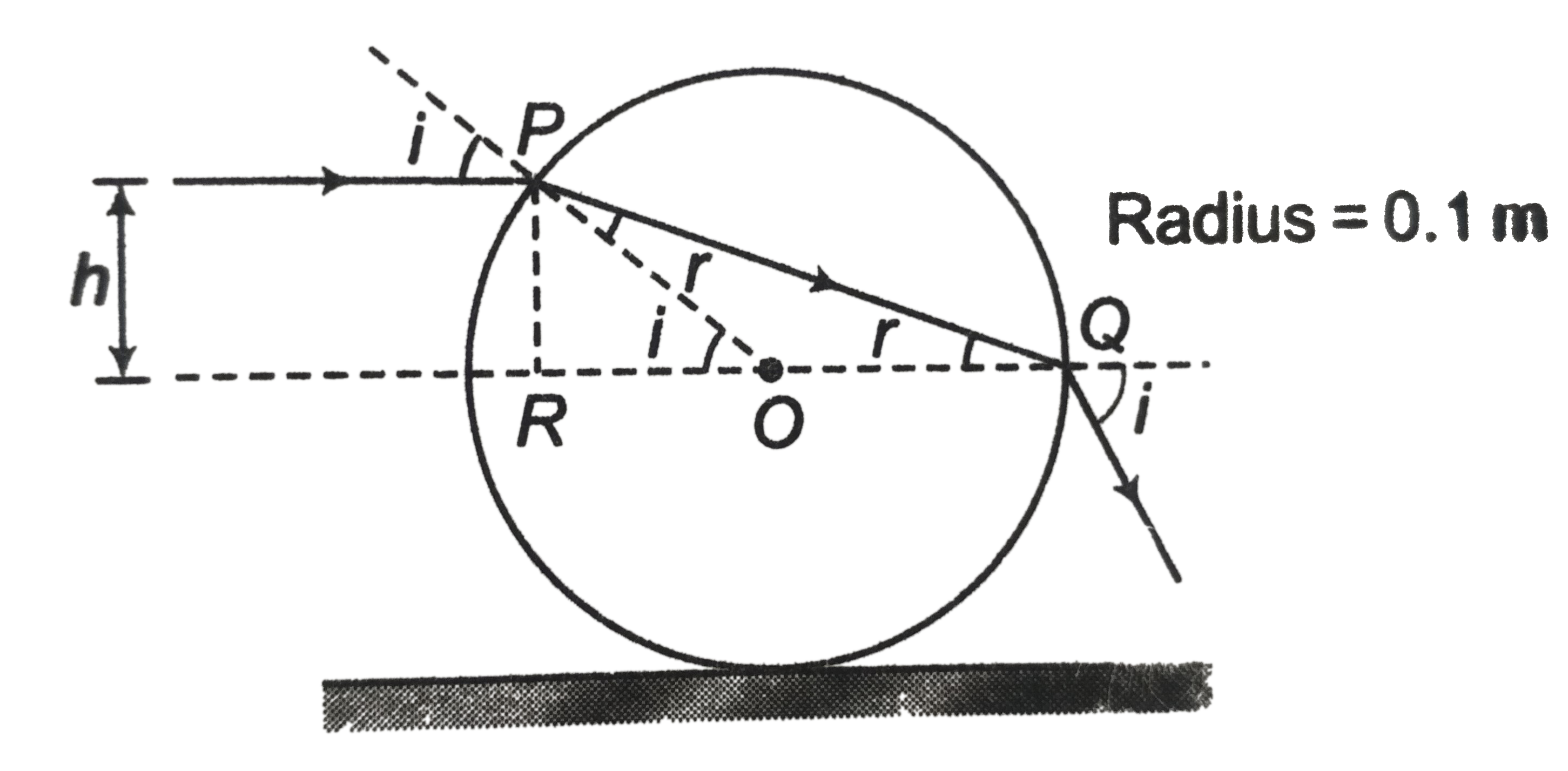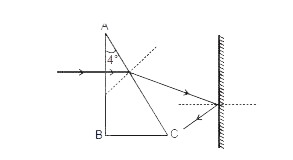A cylinderical glass rod of radius 0.1m and refractive index √3 lies on a horizontal plane mirror. A horizontal ray of light moving perpendicular to the axis of the rod is incident on it. At what height from the mirror should the ray be incident so that it leaves the rod at a height of 0.1m above the plane mirror? At what centre to centre distance a second similar rod, parallel to the first, be placed on the mirror, such that the emergent ray from the second rod is in line with the incident ray on the first rod?

The correct Answer is:A, C
(i) PO=OQ
∴∠OPQ=∠OQP=r(say)

Also, i=r+r=2r
In ΔPQR,h=OPsinI=0.1sint
=0.1sin2r
or h=.0.2simrcosr……(i)
Also √3=sinisinr=2sinrcosrsinr
=2cosr
∴r=30∘
Substituting in Eq. (i), we get
h=0.2×12×√32
=0.086m.
Hence, height from the mirror is
0.1+0.086=0.186m
(ii) Use the principle of reversiblity

i=2r=60∘
Now, QSMS=coti=cot60∘=1√3
∴QS=MS√3=0.1√3
∴ The disered distance,
OC=2×0.1+2×0.1√3
0.315
Topper's Solved these Questions
- REFRACTION OF LIGHTBOOK - DC PANDEYCHAPTER - REFRACTION OF LIGHTEXERCISE - Level 2 Single Correct
41 Videos
- REFRACTION OF LIGHTBOOK - DC PANDEYCHAPTER - REFRACTION OF LIGHTEXERCISE - Single Correct Option
3 Videos
- REFRACTION OF LIGHTBOOK - DC PANDEYCHAPTER - REFRACTION OF LIGHTEXERCISE - Level 1 Subjective
29 Videos
- REFLECTION OF LIGHTBOOK - DC PANDEYCHAPTER - REFLECTION OF LIGHTEXERCISE - Subjective
9 Videos
- SEMICONDUCTORSBOOK - DC PANDEYCHAPTER - SEMICONDUCTORSEXERCISE - Subjective
12 Videos
Similar Questions
A cylindrical glass rod of radius 0.1m and refractive index √3 lies on horizontal plane mirror. A horizontal ray of light moving perpendicular to the axis of the rod is incident on it. At what height from the mirror should the ray be incident so that it leaves the rod at a height of 0.1m above the plane mirror ? At what distance a second similar rod, parallel to the first, be placed on the mirror, such that the emergent ray from the second rod is in line with the incident ray on the first rod ?
View Solution
A plane wave front of light is incident on a plane mirror. Intensity is maximum at P when
View Solution
Knowledge Check
A plane mirror reflecting a ray of incident light is rotated through an angle of 30∘ about an axis through the point of incidence in the plane of the mirror and perpendicular to the plane of incidence then
Athe incident ray is fixedBthe reflected ray rotates through an angle θCthe reflected ray rotates through an angle θ/2Dthe reflected ray rotates through an angle of 2θIf angle fo incidence of a light ray on a plane mirror is 30∘ , then
AThe angle of reflection is 30∘BThe glancing angle of incidence is 60∘CThe angle of deviation is 120∘DAll of theseA plane mirror, reflecting a ray of incident light, is rotated through an angle θ about an axis through the point of incidence in the plane of the mirror perpendicular to the plane of incidence, then
AThe reflected ray does not rotateBThe reflected ray rotates through an angle θCThe reflected ray rotates through an angle 2θDThe incident ray is fixed
A prism having a refracting angle 4∘ and refractive index 1.5 is located in front of a vertical plane mirror as shown. A horizontal ray of light is incident on the prism. What is the angle of incidence at the mirror ?

View SolutionRays of light are incident on a plane mirror at 40∘. At what angle with the first should a second mirror be placed such that the rays emerge from the second mirror parallel to the first mirror.
View SolutionRays of light are incident on a plane mirror at 40∘. At what angle with the first should a second mirror be placed such that the rays emerge from the second mirror parallel to the first mirror.
View SolutionTwo plane mirrors are inclined to each other at an angle 60∘ if a ray of light incident on first mirror parallel to the second mirror, it is reflected from the second mirror
View SolutionA light ray incident on a plane mirror gets reflected from it. Another plane mirror is placed such that the reflected ray from the first mirror is incident on it If the reflected ray from the second mirror travels perpendicular to the indecent ray on the first mirror, determine the angle between two plane mirrors.
View Solution
